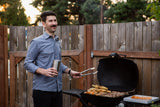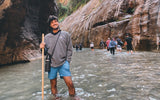How to be Conscious of Special Needs Hikers and Campers

(Words and Photos: Jennifer Allen)
Hiking with kids was a given. The fresh air, the exercise, the perspective shift as we step away from all that bogs us down: what’s not to love? It was only natural that we would share this passion with our kids. Our oldest son completed more trails in utero than many people will in a lifetime. He bounced along in carriers for the first year of his life, and we took the trails more slowly as he learned to walk them on his own. How hard could family hiking be as we added a second and third child to the mix?
When we found out that our middle child would never walk, we had to do some serious mental adjusting. I couldn’t begin to wrap my mind around what life would look like for someone who couldn’t use his legs. At first, I thought the trail was gone. In fact, I envisioned the five of us being trapped in the playroom for the rest of our lives. “Diagnosis Day” can do scary things to your mind.
After I got over the initial shock, I was determined to stop focusing on the "problem" and find solutions. Since then, we've been exploring the world around us and inspiring and enabling other special needs families to do the same. I share Cascade Mountain Tech’s heart for achievable adventure, and the strong belief that the outdoors should be accessible for everyone. I’m excited to contribute to their family hiking resources by sharing how you can make a difference in inclusion on the trail.

What does “special needs” mean?
For the purpose of this article, we're going to define special needs as "extra needs" - namely, anyone who needs something extra in order to be able to hike.
How many special needs hikers are there?
A lot more than you realize! About 20% of the U.S. population lives with some sort of disability or special need. Keep in mind that many of these people are in family groups, which means that about 50% of the population is impacted by a disability. For example, only one person in my family of five has a disability; but, if he can't do a trail, none of us are going on that hike!
How do I know when I see one?
Sometimes these needs are obvious: a man in a wheelchair; a girl with a support cane and dark glasses. Sometimes these needs are completely invisible, or only noticeable because of behaviors that seem out of the norm.

What should I do? How can I help make the trail a better place for them?
I am so glad you asked! Here are six tips for making the trail more inclusive:
#1. Be kind.
I know that seems like something that should go without mentioning, but sometimes we're uncomfortable with things outside of our understanding. We worry about what to say, or what not to say, instead of just saying "hello." For the record, "hello" is always ok.
#2. Pay attention.
A special need or disability doesn't mean a person is incapable of the task they’re attempting. If someone is wheeling along just fine, it would be rude to offer to push their wheelchair (would you offer to carry a walking adult?). If you come across a child walking the trail on his own, he may not have the ability to ask for help, or even to realize that he is lost. Always be alert to the people around you. With a little bit of extra attention, you can often tell if help is needed.

#3. Always offer, and never insist.
If you see a mom struggling up and down a steep section of trail to carry a wheelchair and then come back for her son, it's not rude to offer help. Whatever the response, respect it. Sometimes what looks really hard and overwhelming to you may just be routine, but sometimes it's really hard and overwhelming!
More than once, I've started a trail that looked like we would be able to manage, only to find that the entrance and/or sign post labels were misleading. I've gotten to a place where I've felt totally stuck, with three kids on my own, not sure how to get us out. Sometimes, I've been rescued by a kind soul who sees the need and has the heart to offer help. Other times, I've carried one on my shoulders, and one in my arms, while I drug the other one along by his hand, because I wasn't sure who to bother for help.
#4. Address the appropriate individual.
In most cases, this is the person with special needs. This goes back to my first point: don't avoid eye contact or conversation because the special need makes you uncertain. Most people, even children, appreciate being able to speak for themselves. It’s uncomfortable when you ask questions about an adult to another adult - sometimes just a friend they’re out for a hike with.
The exception to this is when you are offering help to a child, In that case, address the parent. Think of it like when you're offering candy to a child - it's best to ask a parent first because the parent knows any dietary restrictions and is responsible for the wellbeing of the child. Well-meaning adults often offer to push my son's wheelchair, or hold his hand to walk. Because we're striving towards independence, "helpful" offers like this are actually counterproductive. Sometimes a little bit of struggle is just a stepping stone towards improved strength and independence.

#5. Be gracious.
Because we all have such differing needs, you'll see things that don't make sense to you. Just remember, different isn't bad - it's just different. If you see a seven-year-old in a carrier, don't assume he's lazy. There are a plethora of reasons (that you can't see) why he may need to be carried. Don't comment on how lucky he is to be able to be carried down the trail - there's nothing "lucky" about not being able to walk. There are parenting comments and actions that may appear to be a lack of discipline, or too harsh of a correction - but remember that children with special needs process differently and may not respond well to the same parenting techniques you're used to. If you’re hugged by a stranger who says she loves you, or shouted at by a passerby - the chances are high that these are special needs showing themselves in ways you might not expect. Just be gracious in your response.
#6. Be considerate of where you park.
This may be the easiest way to help, and the most often ignored. Inevitably, when I poll my audience for articles like this, parking comes up. If you don't have a handicap placard and a person with a disability, don't park in handicap parking. This is especially an issue for hiking trails and other outdoor adventure spots. It's easy to assume that if someone is hiking, they don't need a handicap space. The truth is, they may be hiking with an adaptive chair - and they can't even get out of the van because the handicap space with built-in room for unloading is taken. I've heard so many parents say that they give up and go home because of the lack of ability to get their kid and equipment out of the car, completely missing out on the adventure altogether! Such a silly little thing that can make a huge difference in accessible adventures. Other families may just have very limited stamina. That up-close parking space may enable them to get some trail time. When my son was using a walker, we went to an event that was going to require a moderate amount of walking. There was an entire lot for handicap parking by the entrance. It was full and not a single vehicle in the lot had a handicap placard. We ended up having to park at an off-site lot and walking about two city blocks to the event. Not a big deal for most families, but by the time we got there, he was done walking and we weren't able to enjoy the event.
Remember that you are the greatest impact on inclusion.
Some of the least physically accessible places we’ve visited have been the most inclusive, because people have worked with us to remove barriers. With help from strangers, we made it up over 800 steps to take in the waterfalls. With the great patience of the hikers behind us, we made it back down. You have the ability to make the world accessible by following the tips above. Keep your eyes open, and be ready to respond with kindness. Thank you for making the outdoors accessible for everyone!
-
Shop the gear from this post:





